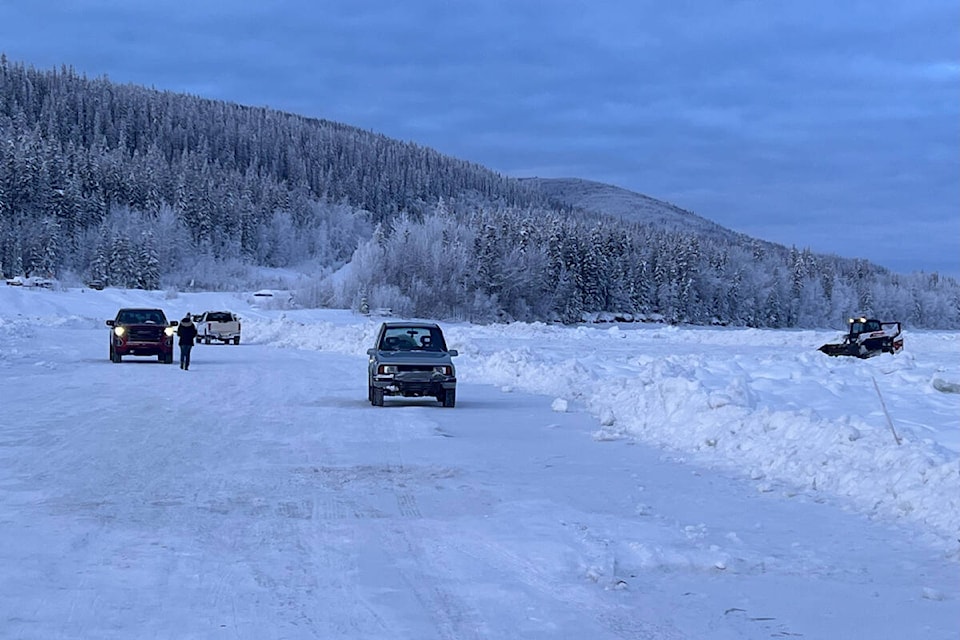The sanctioned ice bridge that the Yukon government typically gets built to connect Dawson City to West Dawson has yet to open this season. It’s usually in place from around late December or early January to April.
The Yukon government’s website and the latest status update on the ice bridge note that open water at the bridge location has hindered its building.
“Avoid crossing the river by any method until the ice bridge is in place. Crossing the river before the ice bridge is in place is dangerous and could lead to injury or death,” reads the Yukon government website.
The bridge is made by spraying water on ice that has formed, which helps it freeze in layers. This technique doesn’t work when there’s open water, according to the status update.
The government hopes that cold weather will allow for ideal conditions for ice to form soon.
The construction project has already gone out to tender, which closed on Nov. 9, 2023. The contract has not been awarded. It will be awarded after river conditions are favourable for constructing an ice bridge, a department spokesperson said by email.
“We will start to build the bridge when the conditions are favourable and safe,” reads the status update, which indicates that an ice jam at the confluence of the Klondike and Yukon rivers has prolonged the usual freeze-up.
Briefing notes prepared for the Highways and Public Works minister for the 2023 fall sitting of the Yukon Legislative Assembly state there was no official ice bridge in 2016-17 or 2017-18 due to environmental conditions. In 2013-14, an alternate route for the ice bridge was taken due to ice conditions that prevented building at the typical location.
After the ice bridge is regularly closed and decommissioned, the George Black Ferry is used between May and October, per the briefing notes.
There is no sanctioned river crossing at least twice a year — in the spring and fall — when the ice bridge and the ferry are both out of commission. The gap in service, in addition to climate change and the age of the ferry, are why the Yukon government is seeking feedback from residents about the river crossing, per the briefing notes.
“The feedback collected will help guide Government of Yukon staff in discussions on the future of the Yukon River crossing in Dawson City,” reads a government press release issued on Jan. 12. “Engagement with impacted communities, First Nations, stakeholders and audiences will continue as the project progresses.”
Feedback has been collected from approximately 600 residents through an online survey and public open houses, per the release.
Here’s what residents had to say, according to the government’s “what we heard” report.
Regarding the operations of the ice bridge and the ferry, at the open house, there were “many positive comments” about the bridge and its maintenance by contractors and some comments about the bridge being “unreliable” and taking too long to build due to climate change, per the report. Others commented on the safety risk when the official bridge is late or doesn’t happen and raised questions about the cost to the government and whether locals should set up the ice bridge to save money.
Respondents at the open house were torn about whether the ferry is meeting their needs and most suggestions about the future of the ferry focused on building a structural bridge for full-year access. The reliability of the aging ferry and the impact it has on residents and tourists were also expressed, as were lineups during peak tourist season.
Environmental, financial, tourism, heritage and other things were considered.
Respondents suggested potential options for the river crossing including a bridge, an energy-efficient ferry, a combination of a ferry and a pedestrian bridge, a cable car and a gondola.
The government heard that any developments to come should consider increased traffic and climate change, while others advocated that development decisions should be driven by the community and not the mining industry.
For some respondents, the “freeze up and break up” are just “part of the unique West Dawson culture,” per the report.
In total, 462 out of the 2,108 Dawson residents responded to the survey, which had a 21.5 per cent response rate. (The Yukon Bureau of Statistics has a higher population count, with a difference of 262, as of June 2023.)
Survey responses suggest 37 per cent of respondents view year-round ability to cross the river as important. Forty-two per cent of respondents indicated it was somewhat important and another 21 per cent indicated it wasn’t important.
Half of the respondents were somewhat satisfied with the current options for crossing the river. Eighteen per cent were very satisfied and 32 per cent weren’t satisfied, according to the report.
“By incorporating the information gathered in this public engagement, we aim to align our projects with the values and priorities of our residents. This input will be carefully considered in how we proceed,” reads the report.
Per the report, public engagement and consultation will continue.
Contact Dana Hatherly at dana.hatherly@yukon-news.com
